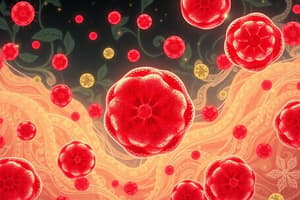Podcast
Questions and Answers
What is the primary function of plasma coagulation factors?
What is the primary function of plasma coagulation factors?
- To regulate blood pressure
- To dissolve blood clots
- To stimulate platelet aggregation
- To facilitate the coagulation cascade (correct)
Which of the following is NOT a plasma coagulation factor?
Which of the following is NOT a plasma coagulation factor?
- Albumin (correct)
- Prothrombin
- Factor IX
- Fibrinogen
What is the consequence of a deficiency in plasma coagulation factors?
What is the consequence of a deficiency in plasma coagulation factors?
- Impaired immune response
- Anemia
- Increased risk of blood clots
- Prolonged bleeding (correct)
Which plasma coagulation factor is responsible for converting fibrinogen to fibrin?
Which plasma coagulation factor is responsible for converting fibrinogen to fibrin?
What is the term for the process by which plasma coagulation factors interact to form a blood clot?
What is the term for the process by which plasma coagulation factors interact to form a blood clot?
Flashcards are hidden until you start studying
Study Notes
Coagulation Factors in Plasma
- Plasma coagulation factors are proteins produced by the liver and circulated in the blood plasma.
- They play a crucial role in the coagulation cascade, a process that leads to the formation of blood clots and stops bleeding when a blood vessel is injured.
- There are 13 identified coagulation factors, each with a specific function in the coagulation process.
- Coagulation factors can be classified into two groups: intrinsic pathway factors and extrinsic pathway factors.
- The intrinsic pathway is triggered by damage to the blood vessel wall, while the extrinsic pathway is triggered by tissue damage.
- The coagulation cascade involves a series of chemical reactions that ultimately lead to the formation of a blood clot.
- Coagulation factors are identified by Roman numerals (e.g., Factor VIII, Factor IX).
- Deficiencies or abnormalities in coagulation factors can lead to bleeding disorders, such as hemophilia.
Studying That Suits You
Use AI to generate personalized quizzes and flashcards to suit your learning preferences.




